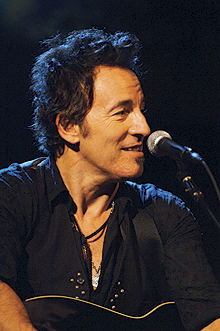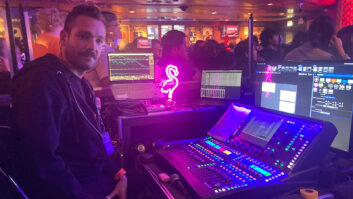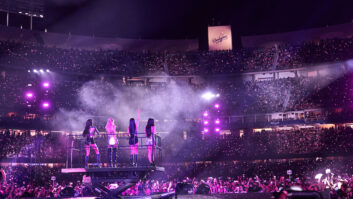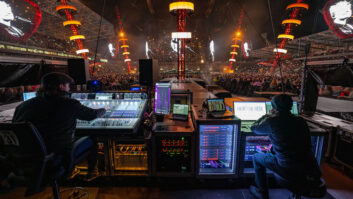
Opening his shows with an admonition to “Turn off your cell phones or I’ll have to cut a swath through the audience with a chain saw!” Bruce Springsteen set the tone for his solo acoustic-oriented Devils and Dust tour (out in support of the same-named album, Springsteen’s 19th album). “And since my sense of rhythm is tenuous at best,” he continues wryly, “please don’t clap along.”
Solo performances take a lot of courage. And when a superstar artist, best known for rocking out with a large band, takes the stage alone (especially as the last solo tour Springsteen performed was in 1996 for the Ghost of Tom Joad), the creative freedom is no doubt giddying and the pressure intense. In an intimate theater, with all eyes — and ears — focused on one person, small errors become glaring and bad sound intolerable.
Few performers can command an arena like Springsteen. He also, obviously, feels the need to showcase his contemplative, troubadour side, and the fans that packed the 2,500 to 7,000-seat theaters and scaled-down arenas for the tour welcomed the opportunity to hear him do so. “Play what you want!” shouted one, as the artist settled in on stage at the lavishly restored deco jewelry box that’s Hollywood’s Pantages Theater (where Mix caught up with The Boss and crew in early May).
Under a pair of chandeliers, with large video screens on each side of the curtained stage, Springsteen performed 26 songs for more than two-and-a-half hours, accompanying himself on harmonica, piano and a collection of acoustic guitars.
Colorado Springs’ Audio Analysts has worked Springsteen’s tours since 1992; out for Dust are front-of-house mixer John Cooper, monitor engineer Monty Carlo and P.A./stage tech T.J. Rodriguez. The tour — which despite its small size onstage comprises three trucks and a total crew, including video, of 17 — uses a JBL VerTec line array system with 32 VT4889s and 16 VT4880 subs, augmented with Meyer CQ2s and M1Ds erected in varying configurations for each venue. At Pantages Theater (a classic proscenium house), the speakers were stacked on each side of the stage with Meyer enclosures covering near-field for the first rows: a CQ2 at each stage corner and M1Ds along the front.
“This is the sixth show and the sixth different P.A. configuration,” comments Cooper. “All the venues are a different size and shape, with different access and [rigging] points. In Asbury Park [N.J.], we did the whole theater with [just] the Meyer speakers onstage. At the Fox [Theatre] in Detroit, we did a single column split 20 feet out on each side, flown with a couple of sub-bass cabinets at the top of each cluster, eight full-range VerTecs underneath that and a small ground stack at each corner.”
A Yamaha DM2000 serves FOH and, except for vocals, Cooper relies on onboard signal processing. No wireless mics are used onstage. [Audio Analysts created a wireless harmonica rig — added after the L.A. show — which comprises a Lectrosonics MM400B transmitter on Springsteen’s harmonica with an M150 lavalier microphone; the receiver is an R400A. The tour is carrying a dual-channel unit with an extra transmitter for backup — Eds.] Guitars take Radial Active direct boxes, and the Yamaha MIDI grand piano uses a Yamaha P-50 sound module. Springsteen sings through a Shure SM58.

Front-of-house engineer John Cooper
photo: Maureen Droney
Cooper uses SIA Smaart Live for room acoustic analysis and tunes the sound system “with Lake I/Os with EQ for each zone and an all-zone EQ for touch-ups on-the-fly. I also use the Crown IQ, which allows me to go into every amplifier onstage and adjust things. With the computer, I have independent level control over each component in each cabinet, so I can deliver the most even sound front to back.”
Cooper archives the shows to 24 tracks of iZ RADAR and uses the recordings for room tuning and tone tweaking, with the return routing from the recorder set so that the tracks come up in their respective stage channels. He also constructed a stomp board by sandwiching a Shure Beta 98 between two pieces of plywood, with anti-skid material on the bottom. Beating time with his boot, Springsteen uses it to good effect for “Reason to Believe,” for which he sings and plays harmonica through a Shure “Green Bullet” mic that feeds a Fender Tweed amp, miked with a Shure Beta 57 for a howling, 1930s/Delta Blues effect.
At the Pantages show, Springsteen began experimenting; At soundcheck, he was auditioning two pump organs. Cooper, whose console inputs are full, scrambles to switch between the two for comparison. “I’ve got eight more preamps coming from our shop tomorrow,” he says. “We’re starting to grow.” Two weeks later, instrumentation had grown to include a Wurlitzer piano and a banjo, with a beat box in the works.
Much of what fills up the 24-fader DM2000 is, Cooper notes, “redundant backup stuff. I’ve got vocals in an outboard circuit [SM58 to Rupert Neve/Amek 9098 preamp and a Tube-Tech compressor], but I always patch to an onboard preamp so it’s on a fader if I need it. The main vocal has two channels of spare; the piano vocal has one.”
Audience mics are key for the recordings: two onstage, three in the audience. “I have them on digital direct outputs to the recorder,” Cooper says. “The two at the stage also go to a recording matrix that feeds the backstage Beta Pro, CD and DVD burners. Bruce takes a DVD with him almost daily to check the show. I spend extra time on the audience mics; you really need them to bring the board mix alive.”

Monitor Engineer Monty Carlo
photo: Maureen Droney
Monty Carlo’s monitor desk is a Midas Heritage 3000, which he notes, seemed large at the outset, but has become — with 30 inputs in use — “just barely big enough.” No in-ear monitors are used (Shure PSM700s are used by an offstage keyboard player who adds sweetening and by the video crew); instead, Carlo runs eight mixes through custom Audio Analyst monitors: eight single 15-inch wedges and two 360-VFX sidefills.
In contrast to the ever-changing FOH P.A., “I’m the same,” says Carlo. “I’ve got two wedges for a center vocal mix. The sidefills are in stereo: guitar, delay effects and piano. The stereo makes it nice and full. The other six wedges are for stereo piano, stereo center guitar and pump organ.”
Carlo’s effects array was slim: two Yamaha SPX-990s and a TC Electronic D2 for “a few delays on vocals and guitars. I’ve never been big on compressors and gates,” he notes. “I have four channels of compressors in a Drawmer DL441 for the vocal, but I don’t do any compression for the stage, just for what the backline techs hear in their speakers. When Bruce switches from vocal to harmonica, the levels jump dramatically; I compress to keep an even level for them.” Outboard EQ is also minimal. “Most of it is in the processors on the amp racks: BSS Minidrives for the crossovers and Klark Teknik DN3600 graphics across the mix buses.”
Carlo, who’s worked with Springsteen for 13 years, sports the calm demeanor characteristic to great monitor mixers: During soundcheck, Springsteen directs few words to him, which is, he acknowledges, “The way we like it. This is a fun tour. There’s a lot of variety. The guitars have very different tonalities, and Bruce often change things up in the middle of a song. Since he’s alone, that’s easy to do, and it keeps things interesting.”
“This tour is pretty luxurious in that sound takes priority over everything,” Cooper concludes. “It’s a wonderful set of problems. You will never, in an arena, get to the point of the quality acoustics we have in these smaller places. It’s a fantastic opportunity.”
The tour wrapped up in the U.S. in mid-May and is currently circling Europe.
Maureen Droney is Mix’s L.A. editor.







